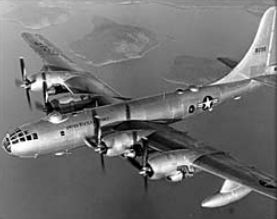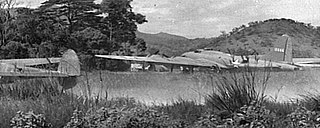
The North American B-25 Mitchell is an American medium bomber that was introduced in 1941 and named in honor of Major General William "Billy" Mitchell, a pioneer of U.S. military aviation. Used by many Allied air forces, the B-25 served in every theater of World War II, and after the war ended, many remained in service, operating across four decades. Produced in numerous variants, nearly 10,000 B-25s were built. These included several limited models such as the F-10 reconnaissance aircraft, the AT-24 crew trainers, and the United States Marine Corps' PBJ-1 patrol bomber.

The Consolidated B-24 Liberator is an American heavy bomber, designed by Consolidated Aircraft of San Diego, California. It was known within the company as the Model 32, and some initial production aircraft were laid down as export models designated as various LB-30s, in the Land Bomber design category.

The Douglas B-18 Bolo is an American heavy bomber which served with the United States Army Air Corps and the Royal Canadian Air Force during the late 1930s and early 1940s. The Bolo was developed by the Douglas Aircraft Company from their DC-2, to replace the Martin B-10.

Nose art is a decorative painting or design on the fuselage of an aircraft, usually on the front fuselage.

The Short S.25 Sunderland is a British flying boat patrol bomber, developed and constructed by Short Brothers for the Royal Air Force (RAF). The aircraft took its service name from the town and port of Sunderland in North East England.

The Martin B-26 Marauder is an American twin-engined medium bomber that saw extensive service during World War II. The B-26 was built at two locations: Baltimore, Maryland, and Omaha, Nebraska, by the Glenn L. Martin Company.

The Consolidated B-32 Dominator was an American heavy strategic bomber built for United States Army Air Forces during World War II, which had the distinction of being the last Allied aircraft to be engaged in combat during World War II; that engagement also resulted in the last American to die in air combat in World War II. It was developed by Consolidated Aircraft in parallel with the Boeing B-29 Superfortress as a fallback design should the B-29 prove unsuccessful. The B-32 only reached units in the Pacific in mid-May 1945, and subsequently saw only limited combat operations against Japanese targets before the formal end of the war on 2 September 1945. Most of the extant orders of the B-32 were canceled shortly thereafter and only 118 B-32 airframes of all types were built.

The Boeing B-50 Superfortress is an American strategic bomber. A post–World War II revision of the Boeing B-29 Superfortress, it was fitted with more powerful Pratt & Whitney R-4360 radial engines, stronger structure, a taller tail fin, and other improvements. It was the last piston-engined bomber built by Boeing for the United States Air Force, and was further refined into Boeing's final such design, the B-54. Though not as well known as its direct predecessor, the B-50 was in USAF service for nearly 20 years.

MDP Wethersfield is a Ministry of Defence facility in Essex, England, located north of the village of Wethersfield, about 6 mi (9.7 km) north-west of the town of Braintree. Originally an RAF station, the original accommodation areas have now been converted to become the headquarters and training centre of the Ministry of Defence Police.

The Memphis Belle is a Boeing B-17F Flying Fortress used during the Second World War that inspired the making of two motion pictures: a 1944 documentary film, Memphis Belle: A Story of a Flying Fortress and the 1990 Hollywood feature film, Memphis Belle. It was one of the first United States Army Air Forces B-17 heavy bombers to complete 25 combat missions, after which the aircrew returned with the bomber to the United States to sell war bonds. In 2005 restoration began on the Memphis Belle at the National Museum of the United States Air Force at Wright-Patterson AFB in Dayton, Ohio where, since May 2018, it has been on display. The B-17 used in the 1990 feature film is housed at the National Warplane Museum in Geneseo, New York.

USAAF unit identification aircraft markings, commonly called "tail markings" after their most frequent location, were numbers, letters, geometric symbols, and colors painted onto the tails, wings, or fuselages of the aircraft of the United States Army Air Forces (USAAF) during the Second World War.

RAF Kimbolton is a former Royal Air Force station located 8 miles (13 km) west of Huntingdon, Cambridgeshire, England.

Piccadilly Lilly II is a B-17 Flying Fortress currently on display at the Planes of Fame air museum in Chino, California. Built in 1945 as a B-17G and assigned serial number 44-83684, this plane was possibly the last aircraft assigned to the Eighth Air Force / 447th Bomb Group, but perhaps not delivered. It was the last active B-17 in the United States Air Force, and retired in 1959 after nine years as a DB-17P drone director. Following its military career, the plane appeared in various television shows and movies.

Nine-O-Nine was a Boeing B-17G-30-BO Flying Fortress heavy bomber, of the 323d Bombardment Squadron, 91st Bombardment Group, that completed 140 combat missions during World War II, believed to be the Eighth Air Force record for most missions, without loss to the crews that flew her. A different B-17G, painted to mimic the Nine-O-Nine, crashed at Bradley International Airport in Windsor Locks, Connecticut, in October 2019.

Old 666 was a Boeing B-17E Flying Fortress heavy bomber, serial number 41-2666, assigned to the United States Army Air Forces (USAAF) 19th and 43rd Bombardment Groups in 1942–1943. It is notable for being the aircraft piloted by Lt. Col. Jay Zeamer Jr. on the 16 June 1943 mission which earned him and 2nd Lt. Joseph Sarnoski each a Medal of Honor, and all other members of the aircrew the Distinguished Service Cross.

The 502d Bombardment Group was a World War II United States Army Air Forces combat organization. The unit was inactivated on 15 April 1946.

Texas Raiders was an American Boeing B-17 Flying Fortress, a B-17G-95-DL built by Douglas-Long Beach. In 1967, it was purchased by the Commemorative Air Force’s Gulf Coast Wing "Texas Raiders" group, which maintained and flew the aircraft out of Conroe-North Houston Regional Airport in Conroe, Texas. The aircraft was destroyed on November 12, 2022, by a mid-air collision with a P-63 Kingcobra at an air show at Dallas Executive Airport, Texas, that killed all five occupants and the P-63 pilot.
Melun Villaroche Aerodrome is an aerodrome located 8.5 km (4.6 NM) north of Melun, a commune in the Seine-et-Marne department in the Île-de-France region in north-central France.

Yankee Lady is an Boeing B-17 Flying Fortress, owned by the Yankee Air Museum of Van Buren Township, Michigan. Originally delivered to the U.S military in 1945, the plane did not see combat action; it was used by the United States Coast Guard for over a decade. Purchased by the museum in 1986, it has since been restored to a World War II configuration and is flown for flight experience rides and airshow appearances.

Boeing B-17G Flying Fortress No.44-83690 is a B-17 Flying Fortress heavy bomber currently undergoing restoration at the Museum of Aviation near Robins Air Force Base in Georgia. It was built as a B-17G-95-DL by the Douglas Aircraft Company and delivered for use on May 9, 1945. It was flown to Grissom Air Force Base for display as a museum piece in 1961. The plane was listed on the National Register of Historic Places in 1993. It was moved to the Museum of Aviation in August 2015.




















